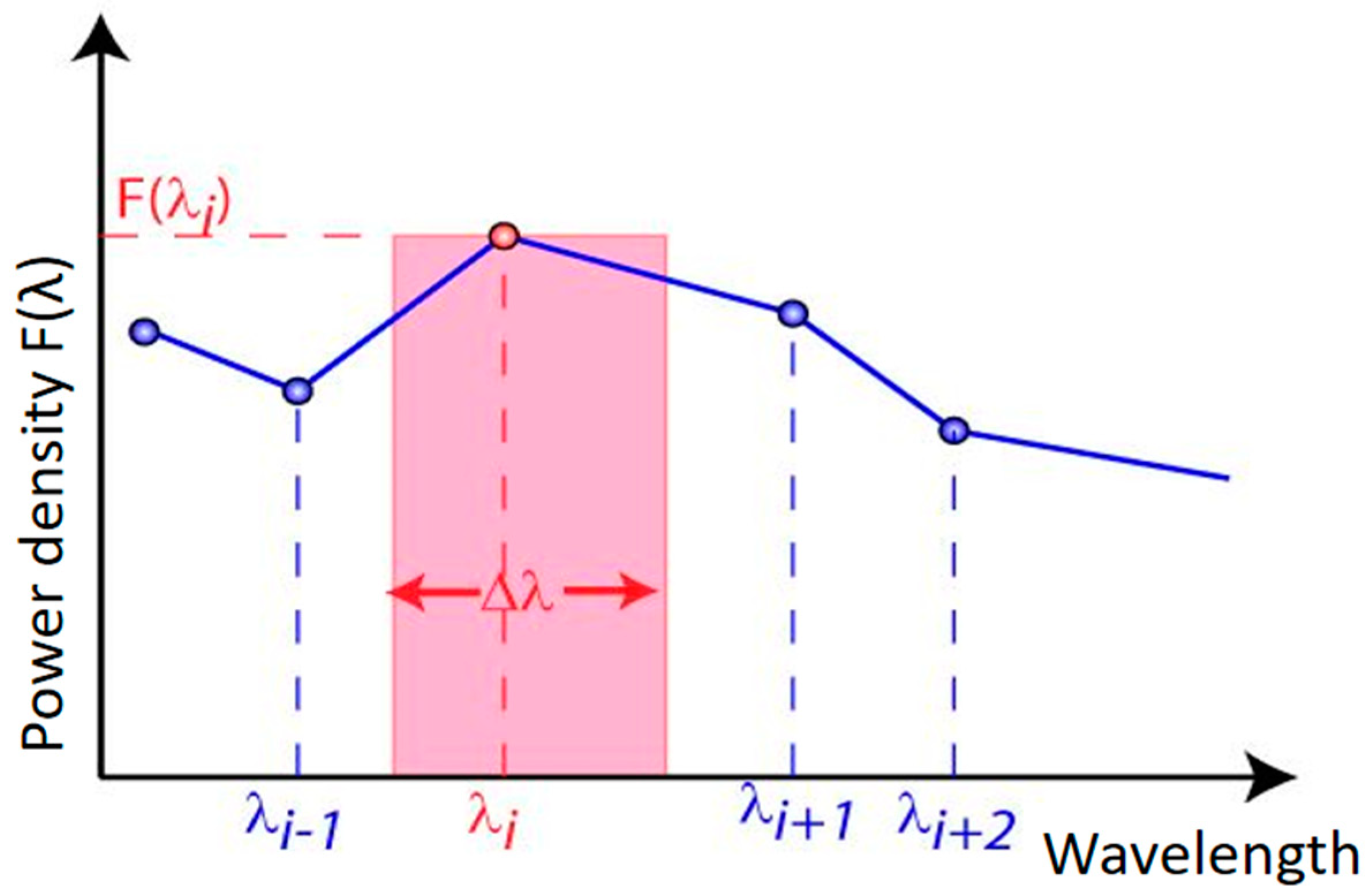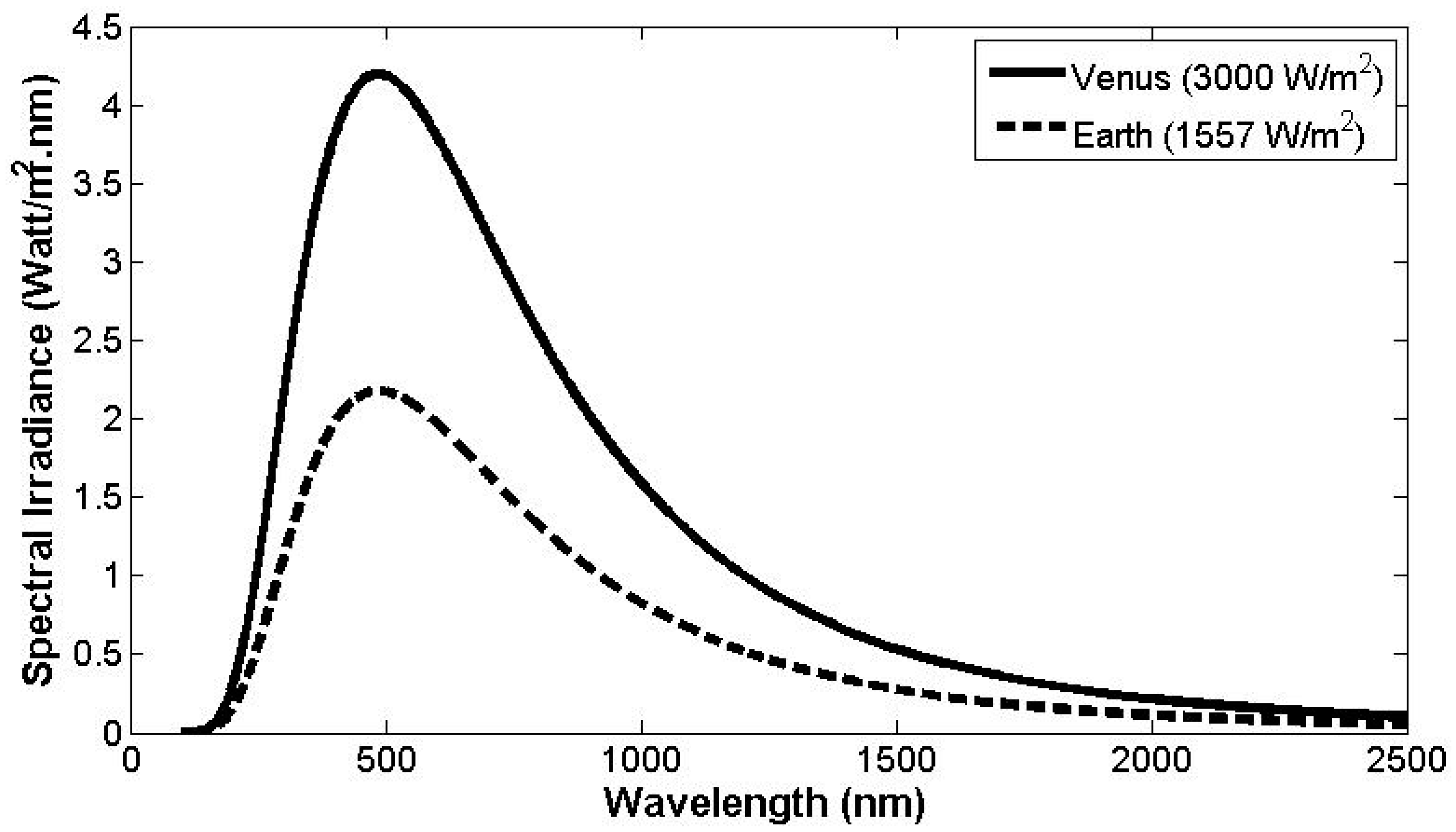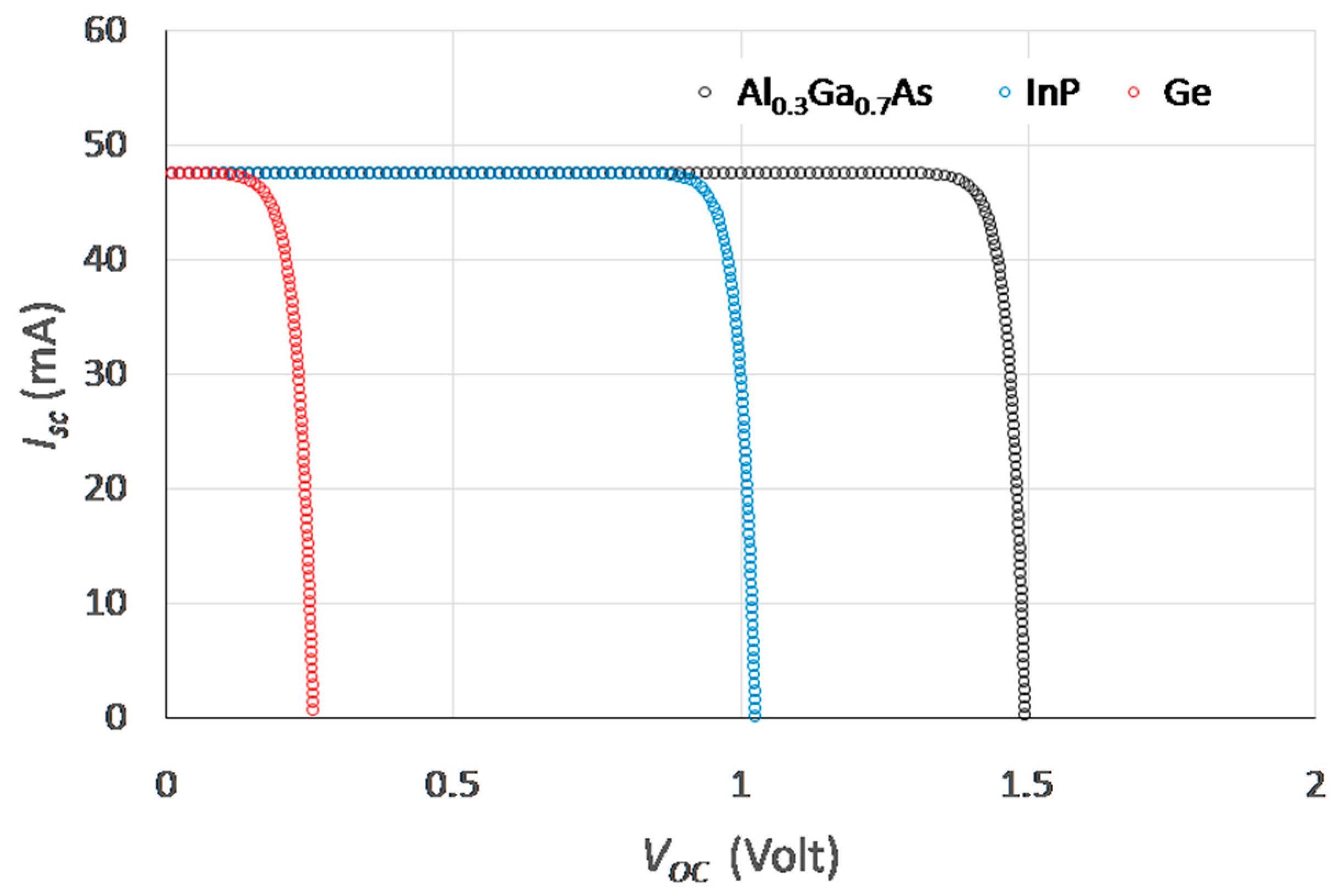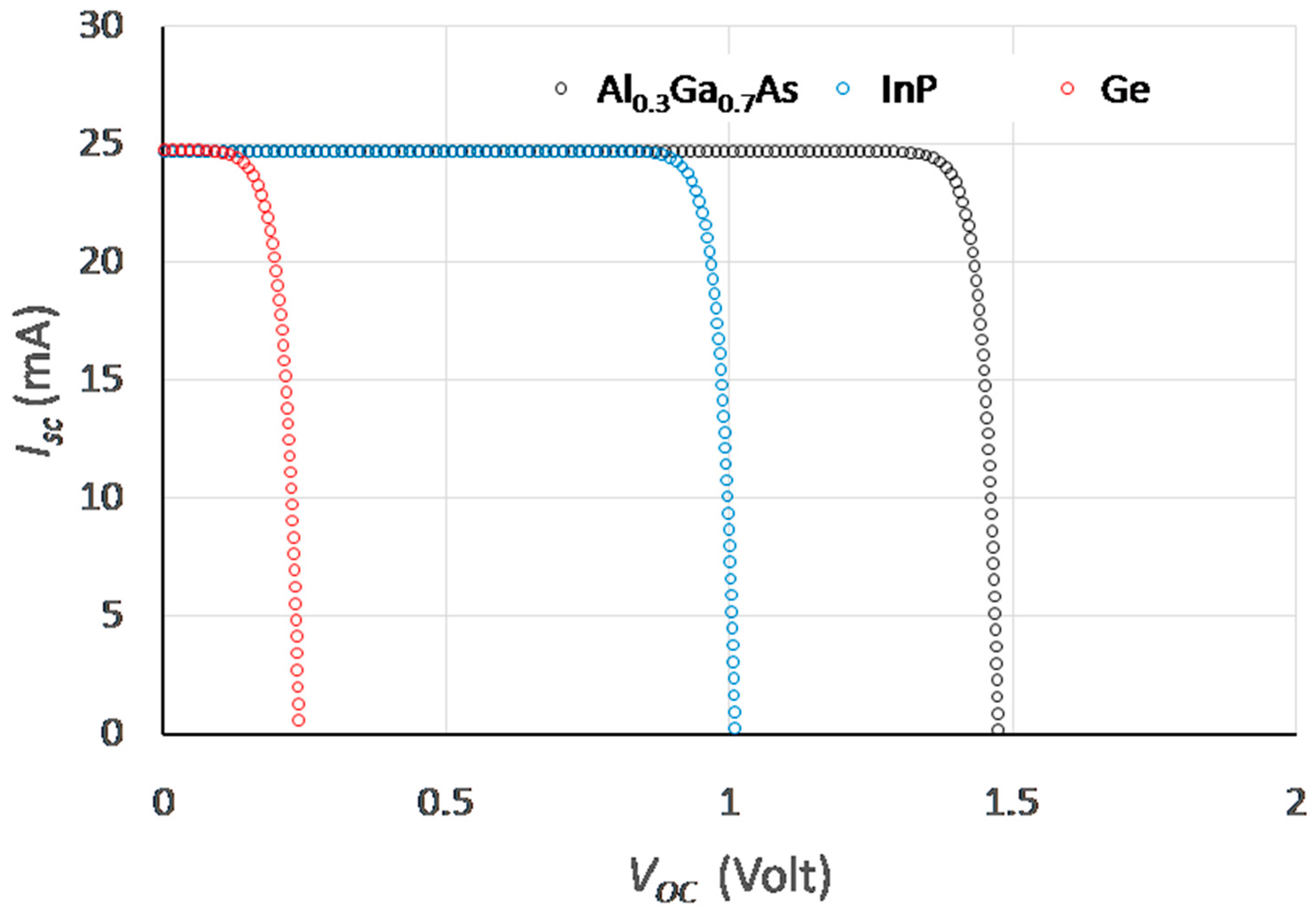Modeling the Output Performance of Al0.3Ga0.7As/InP/Ge Triple-Junction Solar Cells for a Venus Orbiter Space Station
Abstract
1. Introduction
2. Materials and Methods
3. Results and Discussions
3.1. The Solar Radiation Spectrums
3.2. Simulation of the Performance of the Solar Cells at the Geosynchronous Orbit of Venus
3.3. Simulation of the Performance of the Solar Cells at the Geosynchronous Orbit of Earth
4. Conclusions
Author Contributions
Funding
Acknowledgments
Conflicts of Interest
References
- Landis, G.A. Exploring Venus by Solar Airplane. Available online: https://aip.scitation.org/doi/abs/10.1063/1.1357898 (accessed on 26 April 2019).
- Landis, G.A.; Harrison, R. Batteries for Venus Surface Operation. J. Propuls. Power 2010, 26, 649–654. [Google Scholar] [CrossRef]
- Landis, G.A.; Colozza, A.; LaMarre, C.M. Atmospheric Flight on Venus. In Proceedings of the 40th Aerospace Sciences Meeting and Exhibit, Reno, NV, USA, 14–17 January 2002. [Google Scholar]
- Schmidt, G.R.; Landis, G.A.; Oleson, S.R. Human exploration using real-time robotic operations (HERRO): A space exploration strategy for the 21st century. Acta Astronaut. 2012, 80, 105–113. [Google Scholar] [CrossRef]
- Benigno, G.; Hoza, K.; Motiwala, S.; Landis, G.A.; Colozza, A.J. A Wind-powered rover for a low-cost venus mission. In Proceedings of the 51st AIAA Aerospace Sciences Meeting including the New Horizons Forum and Aerospace Exposition, Grapevine, TX, USA, 7–10 January 2013. [Google Scholar]
- Landis, G.A. Robotic exploration of the surface and atmosphere of Venus. Acta Astronaut. 2006, 59, 570–579. [Google Scholar] [CrossRef]
- Landis, G.A. Astrobiology: The case for Venus. J. Br. Interplanet. Soc. 2003, 56, 250–254. [Google Scholar]
- Hunten, D.M. Venus: Atmosphere. In Encyclopedia of the Solar System; Elsevier: Amsterdam, The Netherlands, 2007; pp. 139–148. ISBN 9780120885893. [Google Scholar]
- Landis, G.A. Colonization of Venus. AIP Conf. Proc. 2003, 654, 1193–1198. [Google Scholar]
- Landis, G.A.; Lamarre, C.; Colozza, A. Venus atmospheric exploration by solar aircraft. Acta Astronaut. 2005, 56, 750–755. [Google Scholar] [CrossRef]
- Landis, G.A.; Vo, T. Photovoltaic performance in the venus environment. In Proceedings of the Conference Record of the IEEE Photovoltaic Specialists Conference, Philadelphia, PA, USA, 7–12 June 2009. [Google Scholar]
- Landis, G.A.; Haag, E. Analysis of Solar Cell Efficiency for Venus Atmosphere and Surface Missions. In Proceedings of the 11th International Energy Conversion Engineering Conference, San Jose, CA, USA, 14–17 July 2013. [Google Scholar]
- Landis, G.A.; Mellott, K.D. Stirling Cooler Designed for Venus Exploration. Available online: https://ntrs.nasa.gov/search.jsp?R=20050192311 (accessed on 26 April 2019).
- Jones, C.A.; Arney, D.C.; Bassett, G.Z.; Clark, J.R.; Hennig, A.I.; Snyder, J.C. High Altitude Venus Operational Concept (HAVOC): Proofs of Concept. Available online: https://arc.aiaa.org/doi/abs/10.2514/6.2015-4545 (accessed on 26 April 2019).
- Arney, D.C.; Jones, C.A. High Altitude Venus Operational Concept (HAVOC): An Exploration Strategy for Venus. Available online: https://arc.aiaa.org/doi/abs/10.2514/6.2015-4612 (accessed on 26 April 2019).
- Nakamura, M.; Imamura, T.; Ueno, M.; Iwagami, N.; Satoh, T.; Watanabe, S.; Taguchi, M.; Takahashi, Y.; Suzuki, M.; Abe, T.; et al. Planet-C: Venus Climate Orbiter mission of Japan. Planet. Space Sci. 2007, 55, 1831–1842. [Google Scholar] [CrossRef]
- Horinouchi, T.; Murakami, S.Y.; Satoh, T.; Peralta, J.; Ogohara, K.; Kouyama, T.; Imamura, T.; Kashimura, H.; Limaye, S.S.; McGouldrick, K.; et al. Equatorial jet in the lower to middle cloud layer of Venus revealed by Akatsuki. Nat. Geosci. 2017, 10, 646. [Google Scholar] [CrossRef] [PubMed]
- Zhao, H.; Liu, G.; Zhang, J.; Poplawsky, J.D.; Dierolf, V.; Tansu, N. Approaches for high internal quantum efficiency green InGaN light-emitting diodes with large overlap quantum wells. Opt. Express 2011, 19, 991–1007. [Google Scholar] [CrossRef]
- Lu, C.H.; Li, Y.C.; Chen, Y.H.; Tsai, S.C.; Lai, Y.L.; Li, Y.L.; Liu, C.P. Output power enhancement of InGaN/GaN based green light-emitting diodes with high-density ultra-small In-rich quantum dots. J. Alloys Compd. 2013, 555, 250–254. [Google Scholar] [CrossRef]
- Alfaraj, N.; Mitra, S.; Wu, F.; Ajia, I.A.; Janjua, B.; Prabaswara, A.; Aljefri, R.A.; Sun, H.; Khee Ng, T.; Ooi, B.S.; et al. Photoinduced entropy of InGaN/GaN p-i-n double-heterostructure nanowires. Appl. Phys. Lett. 2017, 16, 161110. [Google Scholar] [CrossRef]
- Arif, R.A.; Ee, Y.K.; Tansu, N. Polarization engineering via staggered InGaN quantum wells for radiative efficiency enhancement of light emitting diodes. Appl. Phys. Lett. 2007, 91, 091110. [Google Scholar] [CrossRef]
- Wang, Z.; Zhang, H.; Wen, D.; Zhao, W.; Zhou, Z. Characterization of the InGaP/InGaAs/Ge triple-junction solar cell with a two-stage dish-style concentration system. Energy Convers. Manag. 2013, 76, 177–184. [Google Scholar] [CrossRef]
- Sun, W.; Al Muyeed, S.A.; Song, R.; Wierer, J.J.; Tansu, N. Integrating AlInN interlayers into InGaN/GaN multiple quantum wells for enhanced green emission. Appl. Phys. Lett. 2018, 112, 201106. [Google Scholar] [CrossRef]
- Zhang, J.; Zhao, H.; Tansu, N. Effect of crystal-field split-off hole and heavy-hole bands crossover on gain characteristics of high Al-content AlGaN quantum well lasers. Appl. Phys. Lett. 2010, 97, 111105. [Google Scholar] [CrossRef]
- Besikci, C. III-V infrared detectors on Si substrates. In Proceedings of the Integrated Optoelectronics, San Jose, CA, USA, 13 April 2000. [Google Scholar]
- Nguyen, H.Q.; Chang, E.Y.; Yu, H.W.; Lin, K.L.; Chung, C.C. High-quality 1 eV In0.3Ga0.7As on GaAs substrate by metalorganic chemical vapor deposition for inverted metamorphic solar cell application. Appl. Phys. Express 2011, 4, 075501. [Google Scholar] [CrossRef]
- Tanabe, K.; Guimard, D.; Bordel, D.; Arakawa, Y. High-efficiency InAs/GaAs quantum dot solar cells by metalorganic chemical vapor deposition. Appl. Phys. Lett. 2012, 100, 193905. [Google Scholar] [CrossRef]
- Yamaguchi, M.; Takamoto, T.; Araki, K.; Ekins-Daukes, N. Multi-junction III–V solar cells: Current status and future potential. Sol. Energy 2005, 79, 78–85. [Google Scholar] [CrossRef]
- Philipps, S.P.; Dimroth, F.; Bett, A.W. High-Efficiency III-V Multijunction Solar Cells. In Practical Handbook of Photovoltaics; Academic Press: Waltham, MA, USA, 2012; pp. 417–448. ISBN 9780123859341. [Google Scholar]
- Essig, S.; Benick, J.; Schachtner, M.; Wekkeli, A.; Hermle, M.; Dimroth, F. Wafer-Bonded GaInP/GaAs//Si Solar Cells With 30% Efficiency Under Concentrated Sunlight. IEEE J. Photovoltaics 2015, 5, 977–981. [Google Scholar] [CrossRef]
- Tanabe, K. A review of ultrahigh efficiency III-V semiconductor compound solar cells: Multijunction tandem, lower dimensional, photonic up/down conversion and plasmonic nanometallic structures. Energies 2009, 2, 504–530. [Google Scholar] [CrossRef]
- Yamaguchi, M. Radiation-resistant solar cells for space use. Sol. Energy Mater. Sol. Cells 2001, 68, 31–53. [Google Scholar] [CrossRef]
- Yamaguchi, M.; Kojima, N.; Khan, A.; Takamoto, T.; Ando, K.; Imaizumi, M.; Sumita, T. Radiation-resistant and high-efficiency InGaP/InGaAs/Ge 3-junction solar cells. In Proceedings of the IEEE International Symposium on Compound Semiconductors, San Diego, CA, USA, 25–27 August 2003. [Google Scholar]
- Bourgoin, J.C.; De Angelis, N. Radiation-induced defects in solar cell materials. Sol. Energy Mater. Sol. Cells 2001, 66, 467–477. [Google Scholar] [CrossRef]
- Torchynska, T.; Polupan, G.; Zelocuatecatl, F.C.; Scherbina, E. Application of III-V Materials in Space solar cell engineering. Mod. Phys. Lett. B 2002, 15, 593–596. [Google Scholar] [CrossRef]
- Dimroth, F.; Grave, M.; Beutel, P.; Fiedeler, U.; Karcher, C.; Tibbits, T.N.D.; Oliva, E.; Siefer, G.; Schachtner, M.; Wekkeli, A.; et al. Wafer bonded four-junction GaInP/GaAs//GaInAsP/GaInAs concentrator solar cells with 44.7% efficiency. Prog. Photovoltaics Res. Appl. 2014, 22, 277–282. [Google Scholar] [CrossRef]
- Dimroth, F.; Tibbits, T.N.D.; Niemeyer, M.; Predan, F.; Beutel, P.; Karcher, C.; Oliva, E.; Siefer, G.; Lackner, D.; Fus-Kailuweit, P.; et al. Four-junction wafer-bonded concentrator solar cells. IEEE J. Photovoltaics 2016, 6, 343–349. [Google Scholar] [CrossRef]
- Sumaryada, T.; Damayanti, N.E.; Rohaeni, S.; Syafutra, H.; Irzaman; Maddu, A.; Hardhienata, H.; Alatas, H. Modeling the Thermal Response of Al0.3Ga0.7As/GaAs/Ge Multijunction Solar Cells. J. Phys. Conf. Ser. 2017, 877, 012030. [Google Scholar] [CrossRef]
- Moon, S.; Kim, K.; Kim, Y.; Heo, J.; Lee, J. Highly efficient single-junction GaAs thin-film solar cell on flexible substrate. Sci. Rep. 2016, 50, 229–235. [Google Scholar] [CrossRef] [PubMed]
- Takamoto, T.; Washio, H.; Juso, H. Application of InGaP/GaAs/InGaAs triple junction solar cells to space use and concentrator photovoltaic. In Proceedings of the IEEE 40th Photovoltaic Specialist Conference, Denver, CO, USA, 8–13 June 2014. [Google Scholar]
- Green, M.A.; Hishikawa, Y.; Dunlop, E.D.; Levi, D.H.; Hohl-Ebinger, J.; Yoshita, M.; Ho-Baillie, A.W.Y. Solar cell efficiency tables (Version 53). Prog. Photovoltaics Res. Appl. 2019, 27, 3–12. [Google Scholar] [CrossRef]
- Sumaryada, T.; Rohaeni, S.; Damayanti, N.E.; Syafutra, H.; Hardhienata, H. Simulating the Performance of Al0.3Ga0.7As/InP/Ge Multijunction Solar Cells under Variation of Spectral Irradiance and Temperature. Model. Simul. Eng. 2019, 9. [Google Scholar] [CrossRef]
- Sumaryada, T.; Sobirin, R.; Syafutra, H. Ideal simulation of Al0.3Ga0.7As/InP/Ge multijunction solar cells. In Proceedings of the AIP Conference Proceedings, Jatinangor, West Java, Indonesia, 7–9 May 2013. [Google Scholar]
- Liou, J.J. Physical models for predicting the performance of Si/Si, AlGaAs/GaAs, and Si/SiGe solar cells. Sol. Energy Mater. Sol. Cells 1993, 29, 261–276. [Google Scholar] [CrossRef]
- Cisneros Tamayo, R.; Torchynska, T.V.; Polupan, G.; Guerrero Moreno, I.J.; Velázquez Lozada, E.; Shcherbyna, L. Photoluminescence of InAs quantum dots embedded in AlGaAs/InGaAs quantum wells with strain reducing layer. Superlattices Microstruct. 2014, 71, 168–176. [Google Scholar] [CrossRef]
- Chiu, P.T.; Law, D.C.; Woo, R.L.; Singer, S.B.; Bhusari, D.; Hong, W.D.; Zakaria, A.; Boisvert, J.; Mesropian, S.; King, R.R.; et al. Direct semiconductor bonded 5J cell for space and terrestrial applications. IEEE J. Photovoltaics 2014, 4, 493–497. [Google Scholar] [CrossRef]
- Ciminelli, C.; Dell’Olio, F.; Armenise, M.N. Photonics in Space: Advanced Photonic Devices and Systems; World Scientific: Singapore, 2016; ISBN 9789814725118. [Google Scholar]
- Sargunanathan, S.; Elango, A.; Mohideen, S.T. Performance enhancement of solar photovoltaic cells using effective cooling methods: A review. Renew. Sustain. Energy Rev. 2016, 64, 382–393. [Google Scholar] [CrossRef]
- Saadah, M.; Hernandez, E.; Balandin, A. Thermal Management of Concentrated Multi-Junction Solar Cells with Graphene-Enhanced Thermal Interface Materials. Appl. Sci. 2017, 7, 589. [Google Scholar] [CrossRef]
- Tiwari, B.; Hossain, M.J.; Bhattacharya, I. GaP/InGaAs/InGaSb triple junction current matched photovoltaic cell with optimized thickness and quantum efficiency. Sol. Energy 2016, 135, 618–624. [Google Scholar] [CrossRef]
- Patel, P.; Aiken, D.; Boca, A.; Cho, B.; Chumney, D.; Clevenger, M.B.; Cornfeld, A.; Fatemi, N.; Lin, Y.; McCarty, J.; et al. Experimental results from performance improvement and radiation hardening of inverted metamorphic multijunction solar cells. IEEE J. Photovoltaics 2012, 2, 377–381. [Google Scholar] [CrossRef]
- Sugaya, T.; Numakami, O.; Oshima, R.; Furue, S.; Komaki, H.; Amano, T.; Matsubara, K.; Okano, Y.; Niki, S. Ultra-high stacks of InGaAs/GaAs quantum dots for high efficiency solar cells. Energy Environ. Sci. 2012, 5, 6233–6237. [Google Scholar] [CrossRef]
- Wanlass, M.; Ahrenkiel, P.; Albin, D.; Carapella, J.; Duda, A.; Emery, K.; Friedman, D.; Geisz, J.; Jones, K.; Kibbler, A.; et al. Monolithic, ultra-thin GalnP/GaAs/GalnAs tandem solar cells. In Proceedings of the IEEE 4th World Conference on Photovoltaic Energy Conversion, Waikoloa, HI, USA, 7–12 May 2006. [Google Scholar]
- Basore, P.A.; Clugston, D.A. PC1D version 4 for Windows: From analysis to design. In Proceedings of the Twenty Fifth IEEE Photovoltaic Specialists Conference, Washington, DC, USA, 13–17 May 1996. [Google Scholar]
- Luque, A.; Hegedus, S. Handbook of Photovoltaic Science and Engineering; John Wiley & Sons Ltd.: Hoboken, NJ, USA, 2011; ISBN 9780470721698. [Google Scholar]
- Bertness, K.A.; Kurtz, S.R.; Friedman, D.J.; Kibbler, A.E.; Kramer, C.; Olson, J.M. 29.5%-efficient GaInP/GaAs tandem solar cells. Appl. Phys. Lett. 1994, 65, 989–991. [Google Scholar] [CrossRef]
- Tukiainen, A.; Aho, A.; Gori, G.; Polojärvi, V.; Casale, M.; Greco, E.; Isoaho, R.; Aho, T.; Raappana, M.; Campesato, R.; et al. High-efficiency GaInP/GaAs/GaInNAs solar cells grown by combined MBE-MOCVD technique. Prog. Photovoltaics Res. Appl. 2016, 24, 914–919. [Google Scholar] [CrossRef]
- Predan, F.; Reinwand, D.; Cariou, R.; Niemeyer, M.; Dimroth, F. Direct wafer bonding of highly conductive GaSb/GaInAs and GaSb/GaInP heterojunctions prepared by argon-beam surface activation. J. Vac. Sci. Technol. A Vacuum Surfaces Film. 2016, 34, 031103. [Google Scholar] [CrossRef]
- Law, D.C.; Liu, X.Q.; Boisvert, J.C.; Redher, E.M.; Fetzer, C.M.; Mesropian, S.; King, R.R.; Edmondson, K.M.; Jun, B.; Woo, R.L.; et al. Recent progress of Spectrolab high-efficiency space solar cells. In Proceedings of the 38th IEEE Photovoltaic Specialists Conference, Austin, TX, USA, 3–8 June 2012. [Google Scholar]
- Dabbabi, S.; Ben Nasr, T.; Turki Kamoun, N. CIGS Solar Cells for Space Applications: Numerical Simulation of the Effect of Traps Created by High-Energy Electron and Proton Irradiation on the Performance of Solar Cells. JOM 2019, 71, 602–607. [Google Scholar] [CrossRef]
- Braun, A.; Szabó, N.; Schwarzburg, K.; Hannappel, T.; Katz, E.A.; Gordon, J.M. Current-limiting behavior in multijunction solar cells. Appl. Phys. Lett. 2011, 98, 223506. [Google Scholar] [CrossRef]





| Subcell | Bandgap Energy | Thickness | p-Doping | n-Doping |
|---|---|---|---|---|
| (eV) | (μm) | (cm−3) | (cm−3) | |
| Al0.3Ga0.7As | 1.817 | 2.889 | 1.00 × 1017 | 3.45 × 1018 |
| InP | 1.350 | 4.222 | 1.36 × 1017 | 1.73 × 1017 |
| Ge | 0.664 | 15.56 | 3.00 × 1018 | 2.13 × 1019 |
| Subcell | Incoming Intensity | Absorbed Intensity | Dissipated Intensity | VOC | Isc | Pmax | FF | Total Efficiency |
|---|---|---|---|---|---|---|---|---|
| mW/cm2 | mW/cm2 | mW/cm2 | (V) | (mA) | (mW) | (%) | (%) | |
| Al0.3Ga0.7As | 300.00 | 136.18 | 71.18 | 1.491 | 47.7 | 65.0 | 91.39 | 38.94 |
| InP | 163.82 | 60.08 | 16.68 | 1.027 | 47.7 | 43.4 | 88.59 | |
| Ge | 103.74 | 19.54 | 11.12 | 0.2548 | 47.7 | 8.42 | 69.28 |
| Subcell | Incoming Intensity | Absorbed Intensity | Dissipated Intensity | VOC | Isc | Pmax | FF | Total Efficiency |
|---|---|---|---|---|---|---|---|---|
| mW/cm2 | mW/cm2 | mW/cm2 | (V) | (mA) | (mW) | (%) | (%) | |
| Al0.3Ga0.7As | 155.70 | 70.70 | 37.40 | 1.474 | 24.8 | 33.30 | 91.09 | 38.15 |
| InP | 85.00 | 31.15 | 9.05 | 1.011 | 24.8 | 22.10 | 88.14 | |
| Ge | 53.85 | 10.13 | 6.13 | 0.238 | 24.8 | 4.00 | 67.77 |
© 2019 by the authors. Licensee MDPI, Basel, Switzerland. This article is an open access article distributed under the terms and conditions of the Creative Commons Attribution (CC BY) license (http://creativecommons.org/licenses/by/4.0/).
Share and Cite
Sumaryada, T.; Fitriansyah, P.; Sofyan, A.; Syafutra, H. Modeling the Output Performance of Al0.3Ga0.7As/InP/Ge Triple-Junction Solar Cells for a Venus Orbiter Space Station. Photonics 2019, 6, 46. https://doi.org/10.3390/photonics6020046
Sumaryada T, Fitriansyah P, Sofyan A, Syafutra H. Modeling the Output Performance of Al0.3Ga0.7As/InP/Ge Triple-Junction Solar Cells for a Venus Orbiter Space Station. Photonics. 2019; 6(2):46. https://doi.org/10.3390/photonics6020046
Chicago/Turabian StyleSumaryada, Tony, Panji Fitriansyah, Afgan Sofyan, and Heriyanto Syafutra. 2019. "Modeling the Output Performance of Al0.3Ga0.7As/InP/Ge Triple-Junction Solar Cells for a Venus Orbiter Space Station" Photonics 6, no. 2: 46. https://doi.org/10.3390/photonics6020046
APA StyleSumaryada, T., Fitriansyah, P., Sofyan, A., & Syafutra, H. (2019). Modeling the Output Performance of Al0.3Ga0.7As/InP/Ge Triple-Junction Solar Cells for a Venus Orbiter Space Station. Photonics, 6(2), 46. https://doi.org/10.3390/photonics6020046





